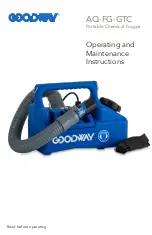
C-5
C.2.2 RABBOCCO
SERBATOIO OLIO
Prima di iniziare il lavoro controllare il
livello dell’olio all’interno del serbatoio: Il
livello, con gru in posizione di riposo e
in orizzontale, deve essere compreso
tra il minimo e il massimo indicati
(vedi §B.6.1). Nel caso in cui il livello sia
inferiore al minimo, è necessario
rabboccare il serbatoio.
Il grado di contaminazione deve essere
inferiore al valore indicato inTab. C-3,
altrimenti si consiglia una pre-filtrazione
con efficienza ß
6-10(c)
≥ 75 (ISO
16889).
RABBOCCO SERBATOIO
1) Portare la gru in posizione di riposo e
in orizzontale, togliere elettricità.
2) Verificare che la temperatura dell’olio
sia tale da non arrecare danni per
ustioni in caso di contatto col serbatoio
(vedi §A.3.1).
3) Svitare il tappo di riempimento situato
nella parte superiore del serbatoio.
4) Riempire il serbatoio sino al livello
max. indicato con olio idoneo
5) Ad operazione ultimata chiudere il
correttamente tappo.
L’olio idraulico è una sostanza
altamente inquinante, pertanto deve
essere movimentato con cura e deve
essere smaltito da azienda
autorizzata (vedi §A.6).
C.2.2 FILLING UP THE OIL
TANK
Before using the crane, check the level
of the tank oil: the level with horizontal
crane at rest, must always be between
the minimum and maximum level
indicated (see §B.6.1).
If the level is under the minimum, fill the
tank up.
The oil contamination level must be
lower than the value indicated in
Tab. C-3, or else we suggest a
prefiltering with efficiency ß
6-10(c)
≥ 75
(ISO 16889).
FILLING UP THE TANK
1) Take the crane to in rest and
horizontal position, switch off.
2) Check that the oil temperature is
such as not to cause damage by
burning in case of contact with the tank
(see §A.3.1).
3) Unscrew the oil filling plug situated at
the top of the tank.
4) Fill the tank up to the max. level
indicated with suitable oil (see §B.6.1,
5) On completing the operation check
that the plug is perfectly closed.
The hydraulic oil is a very
polluting substance: then it is to be
moved with care and to be
discharged by an authorized
company (see §A.6).
C.2.2 AUFFÜLLEN DES
ÖLBEHÄLTERS
Vor dem Kranbetrieb, den Ölstand im
Tank überprüfen: der Ölstand muss bei
ruhiger und horizontaler Stellung des
Krans zwischen die Min. und Max.
Markierung reichen (siehe §B.6.1).
Wenn der Ölstand unter die Min.-
Markierung absinkt, den Ölbehälter
nachfüllen. Die Reinheitsklasse des
Hydrauliköl muss höher als das Wert in
Tab. C-3 sein, anderfalls empfehlen wir
eine Vorfiltration mit Leistungs-fähigkeit
ß
6-10(c)
≥ 75 (ISO
16889).
AUFFÜLLEN DES BEHÄLTERS
1) den Kran in ruhige und horizontale
Stellung bringen, ausschalten.
2) Die Öltemperatur überprüfen, um
Brandwunden im Falle von Berührung
mit dem Behälter zu vermeiden
(siehe §A.3.1).
3) Den Anfüllungsverschluss oben am
Behälter ausschrauben.
4) Den Behälter bis zur Max.
Markierung mit der empfohlenen
Ölsorte auffüllen (siehe §B.6.1,
5) Abschließend sicherstellen, dass der
Anfüllungsverschluss festsitzt.
Das Hydrauliköl ist ein sehr
verschmutzender Stoff: daher muss
es in einem autorisierten Betrieb
abgegeben werden (siehe §A.6).
Tab. C-3 Oli idraulici -
Hydraulic oils
- Hydrauliköle
CARATTERISTICHE OLI IDRUALICI CONSIGLIATI
SPECIFICATIONS OF RECOMMENDED HYDRAULIC OILS
MERKMALE DER EMPFOHLENEN HYDRAULIKÖLE
Temperatura ambiente
Environmental temperature
Umgebungstemperatur
Classe di viscosità
Viscosity grade
Viskositätsgrad
(ISO 3448 / DIN 51519)
Indice di viscosità min.
Min. viscosity index
Min. Viskositätsindex
(ISO 2909)
Max contaminazione olio
Max oil contamination
Min. Reinheitsklasse
(ISO 4406)
Oli consigliati
Recommended oils
Empfohlene Öle
-10°C ÷ 10°C
VG 32
98
18/16/13
BIOHYDRAULIC TMP FR 32
AGIP OSO 32
ESSO NUTO H 32
IP HYDRUS 32
TOTAL AZOLLA ZS 32
10°C ÷ 35°C
VG 46
98
18/16/13
BIOHYDRAULIC TMP FR 46
AGIP OSO 46
ESSO NUTO H 46
IP HYDRUS 46
TOTAL AZOLLA ZS 46
35°C ÷ 40°C
VG 68
98
18/16/13
BIOHYDRAULIC TMP FR 68
AGIP OSO 68
ESSO NUTO H 68
IP HYDRUS 68
TOTAL AZOLLA ZS 68
Summary of Contents for HA10
Page 2: ......
Page 10: ...A 1 A MANUALE AVVERTENZE A WARNING MANUAL A ANWEISUNGSHANDBUCH...
Page 58: ...B 1 B MANUALE D USO B OPERATING MANUAL B BEDIENUNGSHANDBUCH...
Page 117: ...C 1 C MANUALE DI MANUTENZIONE C MAINTENANCE MANUAL C WARTUNGSHANDBUCH...
Page 127: ...D 1 D ALLEGATI D ENCLOSURES D BEILAGEN...
Page 191: ......
















































